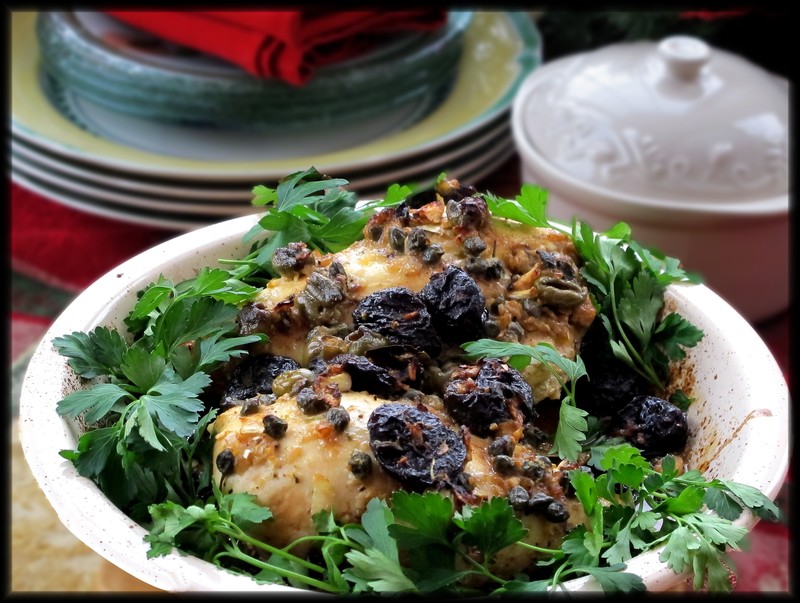Last week, we followed a friend’s recommendation and tried a recipe from the “Silver Palate Cookbook.” Originally published in the early ‘80s, the book is a collection of favorite dishes created by the authors for their New York City gourmet food shop. Like most recipe references, it’s organized by type of food (appetizer, soup, salad, etc.) and includes notes about ingredients and techniques. While “Joy of Cooking” is considered a primer on the basics, “Silver Palate” is a tutorial on how to impress your guests when entertaining.
The suggested recipe was for a dish called Chicken Marbella: marinated chicken parts roasted with olives, capers, prunes and seasonings. It would be an ideal main course for a dinner party or informal gathering, because the preparation is all done in advance. While the chicken roasts (filling the kitchen with essence of garlic and bay leaf), the host has time for any last-minute tasks. It is described as the first main course offered at the shop, and I thought it would be a good recipe to try. However, we had to make a few changes.
First, the quantities had to be scaled back. We needed enough for two people, not 10. The trick to scaling a highly seasoned dish is to be careful which of the ingredients are reduced and how much. It’s one thing to go from four chickens to a single bird, but if you disturb the balance of acid, sweet, salty and tart, you could lose the flavor signature. To address that, we didn’t reduce the quantities in the marinade ingredients by the same factor as the chicken parts.
The next change had more to do with preference than anything else; we skinned the chicken pieces. That allowed the marinade to reach the flesh and perform both flavoring and tenderizing more directly. I assumed the skin was left on to keep the meat from drying out, but that wouldn’t be an issue, since we’d be serving it as soon as it was ready, rather than leaving it in a warming tray in a store window.
Another change was made deliberately: We omitted the brown sugar. According to the instructions it was to be sprinkled over the marinated pieces just before baking, most likely to promote browning and crisping of the skin. The dish certainly didn’t need any more sweetness; the prunes provided that, and we’d already dispensed with the skin. The last change was an accident; we had to leave the chicken in the refrigerator an extra 12 hours, which postponed the roasting and prolonged the marinating.
The results? As you may guess from the photo, after a single bite, we were convinced our version was better than the original. There was no fat to strain from the pan sauce; the meat was moist and highly seasoned, and the overall calorie count was lower. This recipe modification was definitely a success.
Of course, not every recipe can be altered without potentially negative consequences. For example, you can’t change the chemistry between specific amounts of liquid and dry ingredients in cakes, batters and breads. Even more important, you need to follow instructions for leavening agents such as baking powder, baking soda and yeast.
You do have some leeway with sugar. Except when canning jams and jellies, you can usually reduce the amount of sugar by one-third. In cookies and cakes, a rule of thumb is one-half cup of sugar for each cup of flour; for quick breads and muffins, use one tablespoon of sugar for each cup of flour.
As a treat for me, Jack made the apple tarts in the picture for our holiday dessert. He used less sugar than called for and also substituted some vanilla sugar - the results were delicious and gone in a flash. Not only can Jack take great food photographs, he also makes a wonderful tart!
Chicken Marbella For Two
Adapted from the “Silver Palate Cookbook”
1 T olive oil
1 T apple cider vinegar
1 T Balsamic vinegar
1/2 C pitted prunes
1/4 C pitted green olives
2 T capers
4 bay leaves
5 garlic cloves, pureed
1 T oregano
salt & pepper, to taste
2 skinless, bone-in chicken breasts
1/2 C dry white wine
parsley
Combine the olive oil, vinegars, prunes, olives, capers, bay leaves, garlic, oregano, salt, pepper and chicken in a zip-top bag. Turn to thoroughly coat chicken; refrigerate for 8 to 12 hours. Preheat oven to 350 F. Place chicken in a small baking dish or pie plate.
Cover with marinade and pour in white wine. Bake until done, about 55 minutes, basting regularly. Plate chicken pieces, along with olives and prunes; drizzle with pan sauce and garnish with parsley.
Apple Tarts
Adapted from “The Gourmet Cookbook”
2 Granny Smith apples
1/2 C water
1/4 C sugar
1 T vanilla sugar
2 T lemon juice
2 T unsalted butter
1 sheet puff pastry, thawed
Peel, core and halve the apples. Cut into thin slices with a mandolin; place in a glass bowl. In a small saucepan, combine water, sugars, lemon juice and butter. Bring to a boil, stirring until sugar has dissolved. Pour mixture over the apples and set aside saucepan.
Gently stir apples to soften in warm sauce. Place a colander over a bowl and pour in apples, reserving liquid. Preheat oven to 425 F. Line a baking sheet with parchment paper; set aside. Roll out puff pastry on a floured surface. Cut out 6 five-inch rounds and place on prepared baking sheet. Arrange apple slices on pastry rounds, overlapping slices slightly. Bake until pastry is golden, about 25 minutes. While tarts are baking, reduce reserved liquid in saucepan to about 1/3 C. When tarts are done, pour warm syrup over tops. Yield: 6 servings.


















































